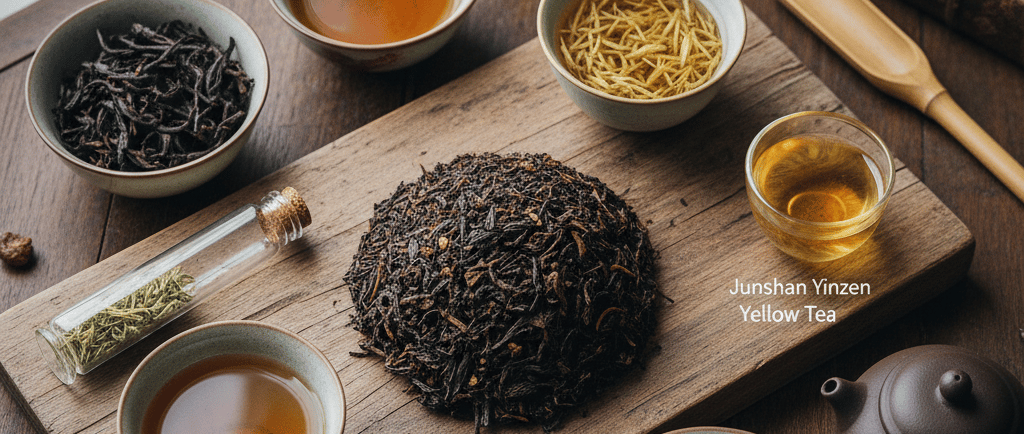Beyond Black and Green: Exploring the World of Lesser-Known Teas that Complement Pu-erh
Explore surprising teas like Yellow Tea and Rock Oolongs that offer the perfect, nuanced counterpoint to Pu-erh's deep, earthy complexity.
PU ERH TEAART OF DRINKINGCEREMONIESCHINESE CEREMONIESTEAANTIOXIDANTHEALTH BENEFITARTCULTURETEA LOVERSCHINACHINESE TRADITIONHEALTHART OF TEA


Beyond Black and Green: Exploring the World of Lesser-Known Teas that Complement Pu-erh
For many, the world of tea is framed by the familiar, comforting shadows of black and green. Yet, for the discerning palate, a deeper, more evocative universe awaits, a realm where Pu-erh, with its earthy gravitas and millennia of layered history, reigns supreme. Pu-erh, whether the vibrant freshness of Sheng (raw) or the deep, fermented complexity of Shou (ripe), possesses a bold character that can dominate. But to truly unlock the artistry of tea appreciation, one must venture beyond the mainstream, seeking out the rare companions that do not merely coexist, but complement and elevate Pu-erh's profound spirit.
It is in the pursuit of harmonious contrast and subtle echo that we discover the true brilliance of lesser-known teas. These aren't the rivals of Pu-erh, but the quiet confidantes whose unique personalities bring an unexpected dimension to the pairing ritual.
The Oolong Whisperers: Minerality Meets Meditation
When seeking a partner for the deep, cellar-like notes of a well-aged Shou Pu-erh, one must turn to the highly oxidized, intensely mineral Rock Oolongs (Yancha) from the Wuyi Mountains of China. Forget the floral, jade-hued Taiwan Oolongs for a moment. Instead, imagine a venerable Da Hong Pao (Big Red Robe). This tea, roasted over charcoal, shares Pu-erh's deep, almost smoky undertone, but carries it with a lighter, crisper elegance. The pairing is a geological meditation: Pu-erh provides the loamy depth and ancient earth; the Rock Oolong introduces the chi of the mountain, a brilliant, clean rock-bone sensation that cuts through the Pu-erh's richness, leaving the palate refreshed and invigorated. It’s a dialogue between earth and stone, where both emerge with greater clarity.
The Emperor’s Gold: A Rare Glimmer of Sweetness
For the brighter, more challenging profile of a young or mid-aged Sheng Pu-erh, which often exhibits assertive bitterness and sharp astringency, a surprising balm is found in the almost mythical Yellow Tea (Huang Cha). This tea, famous for its unique, labor-intensive “smothering” process that yields a mellow, slightly sweet flavor, is a true rarity. A prime example, such as Junshan Yinzhen (Silver Needles from Junshan), offers a warm, buttered corn-silk sweetness and a remarkable lack of bitterness. Served after a robust Sheng, the Yellow Tea acts as a golden ribbon, smoothing the raw edges of the Pu-erh while introducing a sophisticated, honeyed roundness that is utterly enchanting. It is like following a tumultuous, mountain-shaking storm with the gentle, perfect arc of a rainbow.
The Herbal Echo: Forest Floor and Ancient Root
Stepping completely out of the Camellia sinensis family, the realm of herbal infusions holds an unexpected ally, particularly for the seasoned Pu-erh enthusiast. Instead of common mint or chamomile, look to the earthy, slightly bitter embrace of Gynostemma pentaphyllum, commonly known as Jiaogulan or "Southern Ginseng."
While not a true tea, its flavor profile possesses an astonishing affinity for the deep, fungal, and woody notes of Pu-erh. Jiaogulan brings a unique, subtle sweetness—a licorice-like undercurrent—that complements Pu-erh's aged wood and fermentation notes. More importantly, it possesses a clean, invigorating finish that enhances the Pu-erh’s legendary cha qi (tea energy) without overpowering its core flavor. The pairing is a poetic journey back to the primordial forest floor: Pu-erh as the ancient tree trunk, Jiaogulan as the resilient, sweet vine intertwining around its base.
In essence, the journey beyond black and green is a quest for equilibrium. These lesser-known marvels—the mineral chi of Rock Oolongs, the golden serenity of Yellow Teas, and the earthy embrace of Jiaogulan—are not simply substitutes, but keys to unlocking a deeper, more nuanced appreciation of Pu-erh. They remind us that the most beautiful harmonies are often found not in matching notes, but in a courageous and inspired counterpoint. The tea world is vast, and its greatest treasures are often found where the path is least traveled.


